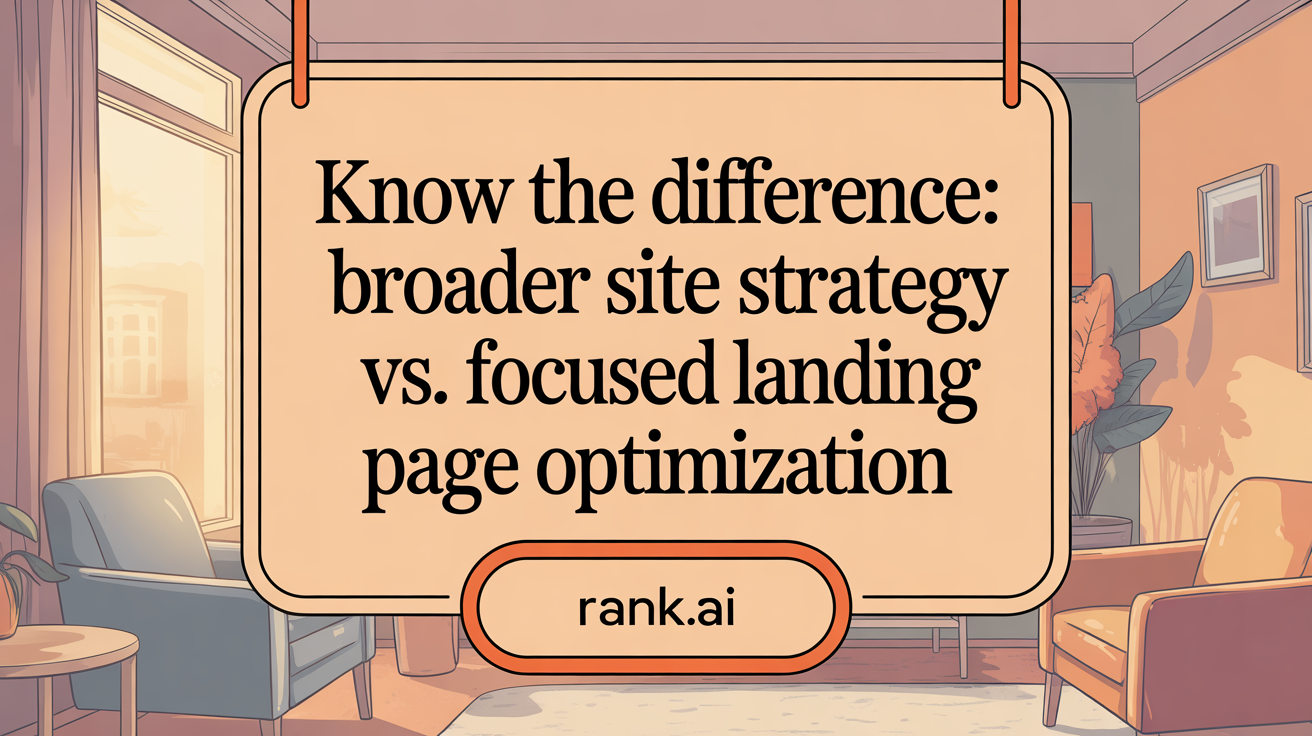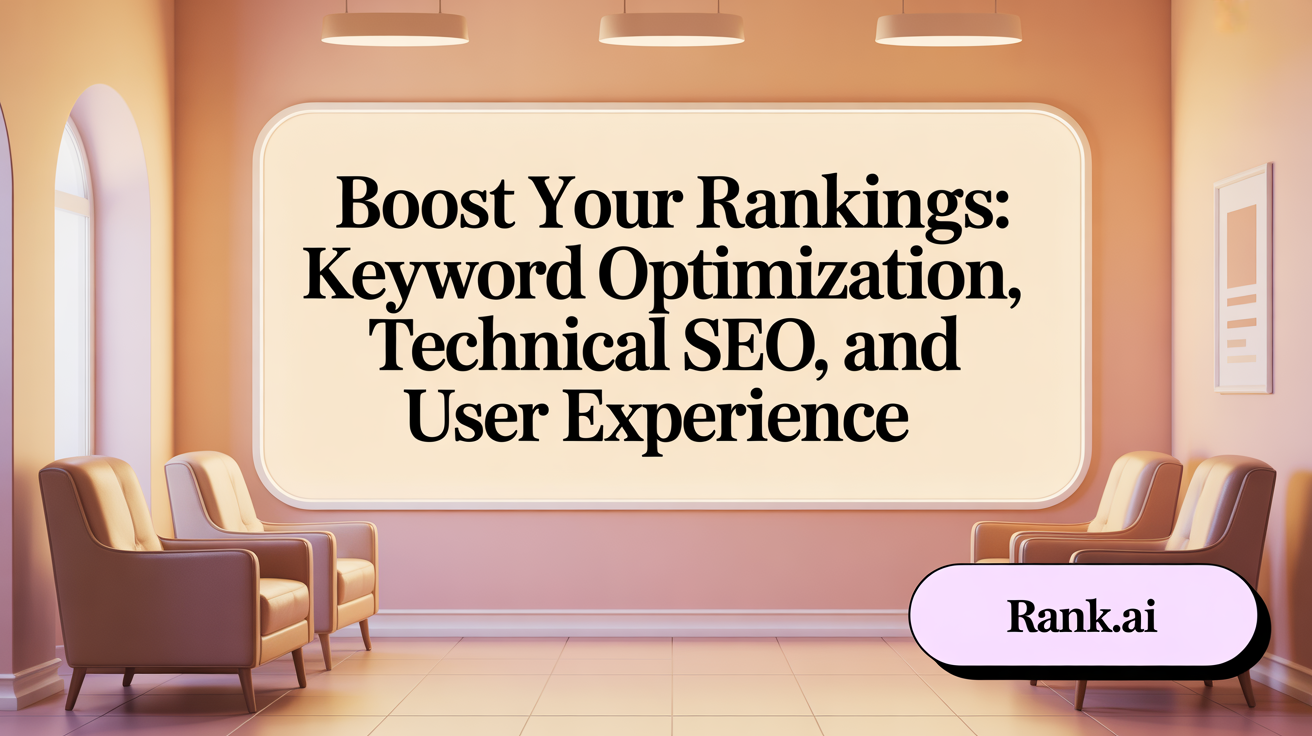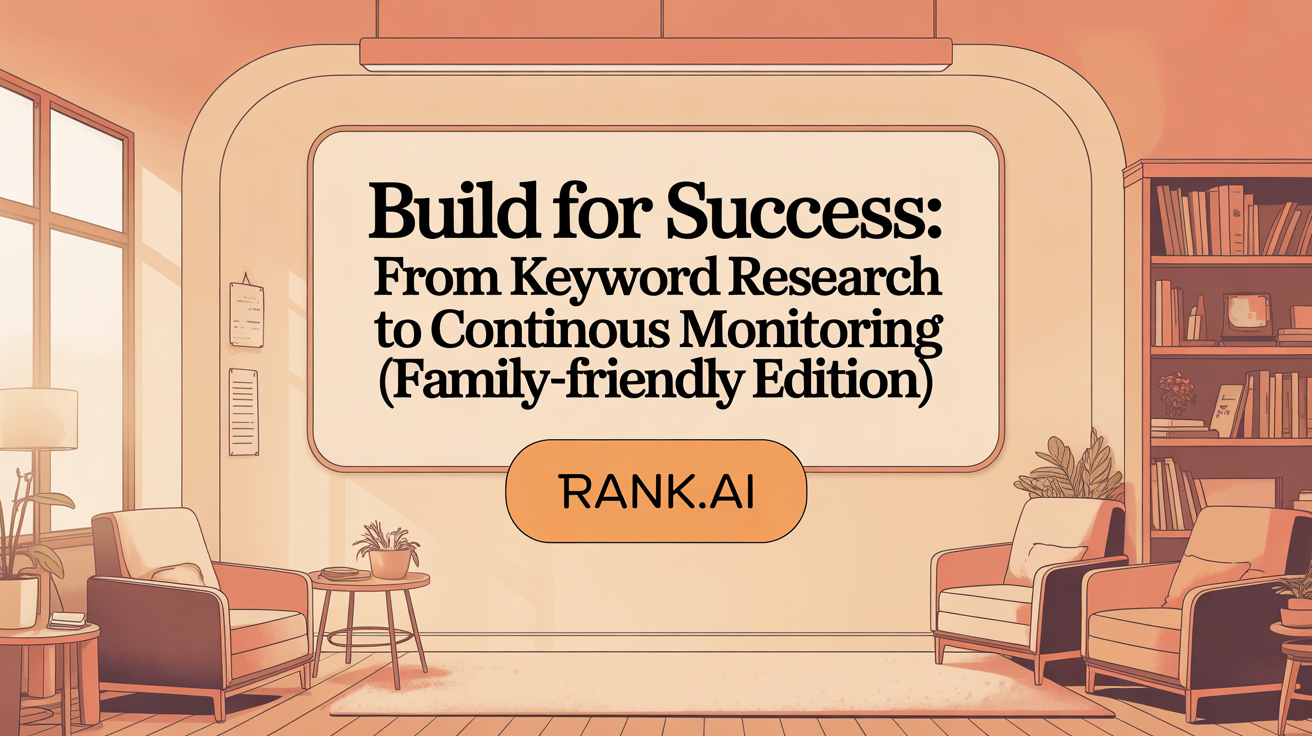Understanding SEO-Friendly Landing Pages
Landing pages play a pivotal role in driving targeted traffic and conversions from search engines. To maximize their impact, these pages must be crafted with SEO best practices tailored specifically to their unique purpose. This article unveils the core elements, optimization strategies, technical considerations, and actionable guidelines for creating and maintaining SEO-friendly landing pages that rank well and engage users effectively.
Core Components of an SEO-Friendly Landing Page
 An effective SEO-friendly landing page combines several essential elements designed to improve search engine rankings and user engagement. High-quality, relevant content is the foundation; it should directly address user search intent and provide value. Incorporating targeted keywords naturally within titles, headers, and meta descriptions helps search engines understand the page’s purpose.
An effective SEO-friendly landing page combines several essential elements designed to improve search engine rankings and user engagement. High-quality, relevant content is the foundation; it should directly address user search intent and provide value. Incorporating targeted keywords naturally within titles, headers, and meta descriptions helps search engines understand the page’s purpose.
A clear, well-organized structure enhances both usability and crawlability. Use descriptive headings and subheadings, along with internal links, to guide visitors and search engines through your content. This navigational clarity encourages longer visits and higher conversion rates.
Mobile responsiveness and fast load times are critical technical aspects. Your page should adapt seamlessly to all devices, especially mobile, as Google prioritizes mobile-first indexing. Speed can be optimized through image compression, efficient hosting, and reducing unnecessary scripts.
Optimized URLs, descriptive alt tags for images, and on-page SEO elements such as appropriate title tags, meta descriptions, and header tags support better visibility. Backlink building from authoritative sites boosts your page’s credibility and authority.
Finally, well-designed calls to action (CTAs) motivate visitors to take desired actions, whether subscribing, purchasing, or contacting. Regular testing and monitoring—using tools like Core Web Vitals—help refine your landing page, maintaining high rankings and conversion performance.
By integrating these components, your landing page will be well-positioned to attract targeted organic traffic, thereby increasing conversions and supporting your overall SEO strategy.
SEO vs Landing Page SEO: Understanding the Differences

What is the difference between traditional SEO and landing page SEO?
Traditional SEO is focused on boosting the overall visibility and ranking of an entire website. It involves broad strategies that target multiple pages across the site, aiming to attract a wide-reaching, often national or global, audience. This approach emphasizes building authority through high-quality backlinks, keyword-rich content, and optimizing site architecture for crawlability.
On the other hand, landing page SEO zeroes in on optimizing a single webpage—specifically designed to serve a targeted purpose. These pages are crafted with specific keywords and content aimed at particular search intents like purchases, sign-ups, or inquiries. The goal is to enhance relevance and maximize conversions by aligning closely with what the user is searching for.
While traditional SEO builds long-term authority for a website and targets numerous keywords, landing page SEO concentrates on relevance and immediate impact. It involves strategic keyword placement within URL structures, headers, content, and metadata, along with optimizing user experience elements like load times and mobile responsiveness.
Local SEO, a subset of traditional SEO, emphasizes geographic relevance through localized keywords, reviews, and Google My Business presence. This strategy helps attract nearby customers but differs from broad SEO tactics by focusing on community-specific search queries.
In summary, the main difference lies in scope: traditional SEO aims to increase overall site visibility across many pages and topics, fostering long-term authority. Conversely, landing page SEO focuses on individual pages designed to rank highly for specific high-intent keywords and to serve immediate conversion goals.
Best Practices for Optimizing Landing Pages for Search Engines

What are best practices for optimizing landing pages for search engines?
Optimizing landing pages effectively can significantly boost their visibility and ranking in search engine results. The process begins with thorough keyword research. Focus on identifying high-intent keywords, especially long-tail and location-specific phrases, using tools like Google Keyword Planner, SEMrush, or Ahrefs. These keywords should align with user search intent to attract visitors most likely to convert.
Once you've selected your target keywords, naturally incorporate them into your content. This includes placing them within the meta titles, meta descriptions, headings, URL structure, and image alt text. Avoid keyword stuffing by ensuring the placement feels organic and relevant.
Technical SEO factors play a crucial role in landing page optimization. Ensure your pages load quickly by compressing images, minimizing code, and leveraging browser caching. Mobile responsiveness is vital, given that over 60% of traffic comes from mobile devices. Using schema markup can improve how your page appears in search results with rich snippets.
Enhance on-page elements by crafting compelling, keyword-rich title tags and meta descriptions that attract clicks. Use clear header tags (H1, H2, H3) to structure your content logically, improving readability and SEO. Internal linking to relevant pages within your website supports better crawlability and distributes page authority.
Regularly audit your landing pages with SEO tools to identify and fix issues like duplicate content, broken links, or slow load times. Monitoring performance through Google Search Console and Analytics helps identify areas for improvement.
Finally, strengthen your off-page SEO efforts by earning backlinks from authoritative sites. Creating high-quality, shareable content that provides real value encourages other websites to link to your landing pages. This combination of on-page, technical, and off-page strategies ensures your landing pages perform well in search engine rankings, attracting the right organic traffic to meet your marketing goals.
Essential Features of SEO-Friendly Landing Page Design and Content

What are the essential features of SEO-friendly landing page design and content?
An effective SEO-ready landing page combines several important elements to improve visibility in search engine results and enhance user experience. First, it should have a clean, intuitive layout that is easy to navigate and provides a seamless experience across all devices, especially mobile. With around 60% of traffic coming from mobile phones, responsiveness is critical.
Strategic placement of keywords is vital. Incorporate relevant keywords naturally into key on-page elements such as the title tag, meta description, headers, image alt texts, and URLs. This alignment with user search intent helps search engines understand the page’s purpose.
Technical SEO factors also play a crucial role. Optimize page load speed by compressing images, leveraging fast hosting, and minimizing code. Implement structured data markup to help search engines better interpret your content. Use descriptive, keyword-rich URLs that are simple and avoid unnecessary complexity.
High-quality, comprehensive content that addresses user questions enhances both engagement and ranking. The content should be valuable, relevant, and tailored to meet the specific intent behind search queries. Combining this with internal linking to other relevant pages and external links to authoritative sources strengthens the page’s relevance.
Adding social proof, such as testimonials or trust badges, along with security features like HTTPS, increases trustworthiness. Local SEO best practices, including location-specific keywords and embedding Google Maps, can attract nearby traffic.
Finally, ongoing testing and updates—such as A/B testing different elements—ensure the landing page remains optimized for both search engines and conversions, adapting to changes in search algorithms and user behaviors.
Step-by-Step Process for Creating or Improving SEO-Friendly Landing Pages

What step-by-step process should be followed to create or improve SEO-friendly landing pages?
Creating effective landing pages that rank well in search engines and convert visitors requires a strategic, step-by-step approach. Begin with comprehensive keyword research to understand what your target audience is searching for. Utilize tools like SEMrush, Google Keyword Planner, or Ahrefs to identify high-volume, low-competition, and long-tail keywords with clear user intent.
Once you have your target keywords, optimize all on-page elements. Craft compelling and relevant title tags and meta descriptions that include your keywords naturally. Use header tags (H1, H2, H3) to structure your content, incorporate keywords thoughtfully, and make sure URLs are clean, descriptive, and keyword-rich with hyphens separating words. Don’t forget to add descriptive alt text to all images, improving both SEO and accessibility.
Content quality is paramount. Develop high-quality, engaging, and relevant content that effectively addresses user questions and needs. Use multimedia such as images, videos, and infographics to enrich the user experience and encourage sharing.
Design your landing page to be mobile-friendly and fast-loading. Optimize images, leverage browser caching, and minimize unnecessary code to enhance site speed, as these factors significantly impact rankings and user satisfaction.
Clear and persuasive calls-to-action (CTAs) are essential to guide visitors toward desired conversions. Tailor your CTAs to match search intent—whether informational, transactional, or navigational.
Implement technical SEO best practices. Use schema markup to help search engines understand your content better. Develop an effective internal linking strategy to pass authority smoothly within your site, and regularly optimize your page speed using tools like Google PageSpeed Insights.
Building quality backlinks remains crucial. Create valuable, original content that industry influencers and other websites want to reference, and conduct targeted outreach to enhance your backlink profile.
Finally, monitor your landing page's performance continuously. Track metrics such as bounce rate, conversion rate, and rankings using Google Analytics and Search Console. Conduct A/B testing on different designs and content elements to optimize for both visibility and conversions. Regularly update and refine your landing pages based on data insights to stay competitive and achieve ongoing success.
Technical SEO Considerations and Strategies for Landing Pages
What technical considerations and SEO strategies are important for landing pages?
Optimizing landing pages from a technical SEO perspective is vital for enhancing their visibility, usability, and conversion potential. One of the most critical factors is mobile responsiveness. Given that around 60% of web traffic comes from mobile devices, ensuring that landing pages are fully responsive and optimized for mobile indexing by Google is essential.
Page load speed is another crucial element. Techniques such as compressing images, minifying CSS and JavaScript files, leveraging browser caching, and utilizing Content Delivery Networks (CDNs) significantly improve load times. Fast-loading pages reduce bounce rates and are favored by search engines.
Structured data and schema markup help search engines understand the content better, which can lead to rich snippets and improved click-through rates. Implementing a clean, keyword-rich URL structure with descriptive, hyphen-separated URLs enhances both user trust and search engine comprehension.
Internal linking improves crawlability by making the site structure clear and distributing authority across key pages. Ensuring the site uses HTTPS with secure protocols enhances security and trustworthiness.
Removing unnecessary navigation elements or reducing distractions on landing pages can focus user attention on the main offers or calls-to-action, increasing conversion rates.
Monitoring Core Web Vitals — including loading performance, interactivity, and visual stability — helps identify areas where user experience can be improved, supporting both SEO and engagement.
By systematically addressing these technical factors, marketers can create landing pages that not only rank higher in search results but also provide a seamless, user-friendly experience.
| Consideration | Strategy | Rationale |
|---|---|---|
| Mobile Responsiveness | Test and optimize for mobile-first index | Ensures compatibility with Google's mobile-first approach |
| Page Load Speed | Compress images, minify code, use CDN | Faster pages improve rankings and reduce bounce rates |
| Structured Data | Implement schema markup | Enhances rich snippets and search visibility |
| URL Structure | Use descriptive, hyphen-separated URLs | Improves clarity and keyword relevance |
| Internal Linking | Use keyword-rich anchor text | Facilitates crawling and distributes authority |
| Security Protocols | Implement HTTPS | Builds trust and complies with search engine policies |
| Simplified Navigation | Remove unnecessary menus | Keeps visitors focused and reduces distractions |
| Performance Monitoring | Track Core Web Vitals and metrics | Identifies technical issues impacting SEO and user experience |
Focusing on these areas ensures your landing pages are well-optimized technically, supporting improved rankings and a better user experience.
Effective Keyword Research and Implementation for Landing Pages
How do I optimize a landing page for SEO?
Optimizing a landing page starts with thorough keyword research. Understanding the search intent behind keywords helps ensure your content aligns with what users are actually looking for. Focus on transactional and long-tail keywords with clear intent to attract visitors ready to convert.
Utilize tools like Google Keyword Planner, SEMrush, and Ahrefs to identify high-volume, low-competition, and relevant keywords. These tools offer insights into search trends, keyword difficulty, and related phrases, enabling you to select the best terms for your niche.
Once you select your keywords, strategically place them throughout your landing page. Incorporate them into the title tag, meta description, headers (H1, H2, H3), URL, image alt texts, and naturally within the content. This helps search engines understand your page’s relevance to specific queries.
Be careful with keyword density; avoid keyword stuffing by maintaining a natural flow in your writing. Your goal is to create engaging, helpful content that provides value while seamlessly integrating targeted keywords.
Align your content with your chosen keywords by addressing user questions and emphasizing relevant benefits. Clear, purposeful content combined with optimized backend elements boosts both SEO and user experience.
Technical factors also matter. Ensure your page loads quickly by compressing images, leveraging browser caching, and choosing reliable hosting. Make your landing page mobile-friendly, as a significant portion of traffic comes from mobile devices and Google’s mobile-first indexing prioritizes mobile usability.
Internal linking from other relevant pages on your site enhances crawlability and authority. Building backlinks from reputable sites through valuable content and outreach strategies further elevates your rankings.
Continuous testing and optimization are essential. Use tools like Google Analytics and Search Console to monitor performance metrics such as bounce rate, page views, and conversion rates. Regular updates and A/B testing help refine your keywords and content for better SEO outcomes.
Promoting your landing pages through social media sharing and outreach not only increases traffic but also encourages backlinks and social signals that boost your ranking.
By implementing a strategic keyword research process and careful on-page optimization, your landing pages can achieve higher search visibility, attract targeted organic traffic, and support your broader marketing goals.
Optimizing On-Page SEO Elements to Boost Landing Page Rankings
How can I optimize title tags and meta descriptions?
Effective title tags and meta descriptions are vital for search engine rankings and attracting clicks. Ensure your title tags include target keywords naturally and are concise, ideally under 60 characters. Meta descriptions should provide a compelling summary of the page, incorporating relevant keywords and staying within 150-160 characters to enhance visibility in search results.
How should I use header tags (H1, H2, H3) effectively?
Header tags structure your content for both users and search engines. Use a single H1 tag for the main title, ensuring it includes primary keywords. Subheadings like H2 and H3 should organize content into logical sections, with relevant keywords where appropriate. This helps search engines understand the content hierarchy and improves readability.
How do I optimize image alt texts and file names?
Images should be optimized to boost accessibility and SEO. Use descriptive, keyword-rich file names that reflect the image content. Alt texts should be clear and include relevant keywords to improve visibility in image search and assist visually impaired users. Avoid keyword stuffing; focus on accurate, natural descriptions.
What’s the best practice for keyword-rich URLs and internal linking?
URLs should be simple, descriptive, and incorporate target keywords separated by hyphens. For example, www.yoursite.com/seo-landing-page. Internal links should use keyword-optimized anchor text to connect related pages, helping search engines crawl your site depth and pass authority to key pages.
How do I avoid duplicate content and ensure unique metadata?
Duplicate content can harm rankings. Use canonical tags to specify the preferred version of a page if similar content exists elsewhere. Create unique titles, meta descriptions, and headers for each landing page, tailored to their specific content and target keywords.
Why is clear call-to-action placement important?
A prominent, compelling call-to-action (CTA) encourages user engagement and conversions. Place your CTA above the fold and at logical points within the content, making it easy to find without overwhelming users. Well-designed CTAs aligned with user intent can significantly improve your landing page’s effectiveness.
Enhancing User Experience Through Design and Content Alignment
How does matching design with user search intent improve SEO?
Properly aligning landing page design with the search intent—whether informational, transactional, or commercial—helps meet user expectations effectively. For example, transactional pages should emphasize clear calls-to-action and easy navigation to convert visitors. This relevance increases engagement, reduces bounce rates, and signals to search engines that the page is valuable, potentially boosting its ranking.
Why is a mobile-first responsive design critical?
With around 60% of web traffic coming from mobile devices, Google has adopted mobile-first indexing. A mobile-responsive design ensures your landing page looks good and functions well on all device sizes. Responsive sites improve user experience, decrease bounce rates, and are favored by search engines, contributing to higher rankings.
How can intuitive layout and navigation enhance user engagement?
An intuitive layout helps visitors find what they need quickly without confusion. Clear menus, logical content flow, and visible CTAs guide users seamlessly through the page. This ease of use encourages longer visits and actions, positively impacting SEO metrics like time on page and conversion rate.
Why is fast load time important?
Page load speed directly affects both user experience and SEO rankings. Slow pages frustrate users, leading to higher bounce rates and lower rankings. Optimizing images, leveraging fast hosting, and minimizing unnecessary plugins can dramatically improve load times, keeping visitors engaged.
How does high-quality, well-structured content improve SEO?
Content that is relevant, informative, and logically organized responds directly to user questions. Proper headers and a natural flow guide visitors and search engines alike. Incorporating multimedia such as images and videos enriches the experience and encourages sharing and inbound links, further enhancing SEO.
What role does multimedia and visual elements play?
Visual elements like images, videos, and infographics attract attention and demonstrate value clearly. They break up text, highlight key points, and keep visitors engaged longer, which can improve time on site and on-page SEO metrics.
How can social proof build trust?
Adding testimonials, client logos, star ratings, and social media links helps establish credibility. Trustworthy pages reduce hesitation, increase conversions, and indirectly support SEO by encouraging shares and backlinks.
| Aspect | Impact on SEO | Best Practices |
|---|---|---|
| Search intent alignment | Improves relevance, lowers bounce rates | Design for specific user goals |
| Mobile responsiveness | Enhances rankings, user retention | Use flexible layouts, test on multiple devices |
| Layout & navigation | Increases engagement, longer sessions | Clear pathways, prominent CTAs |
| Load speed | Decreases bounce, boosts rankings | Optimize images, host on fast servers |
| Content quality | Improves authority, shares, inbound links | Use structured, valuable, keyword-rich content |
| Multimedia use | Boosts engagement, time on page | Incorporate relevant images & videos |
| Social proof | Builds trust, encourages conversions | Display testimonials, reviews, logos |
Creating a landing page that marries thoughtful design with relevant, engaging content tailored to user search intent ensures a better experience for visitors and a higher chance of ranking well in search results.
Building Authority with Backlinks and Internal Linking
Why are backlinks from authoritative, relevant sites important?
Backlinks serve as votes of confidence from other websites, signaling to search engines that your content is valuable and trustworthy. When reputable sites link to your landing page, it boosts your site's authority, helping it rank higher in search results. Relevant backlinks from industry-specific sources are especially powerful because they indicate relevance and trustworthiness within your niche.
How can you secure backlinks through valuable content and outreach?
Creating original, high-quality content such as in-depth guides, infographics, or case studies encourages other sites to link naturally. Outreach involves reaching out to industry influencers, bloggers, and webmasters, sharing your content, and requesting backlinks. Personalizing outreach efforts and emphasizing mutual benefits increases your chances of acquiring valuable backlinks.
What are effective internal linking strategies?
Internal links connect different pages within your website, helping search engines crawl your site more effectively and discover all your valuable content. Use descriptive anchor texts that include relevant keywords to guide both users and search engines. Linking related content, products, or blog posts keeps visitors engaged longer and transfers link equity across your site.
How does keyword-optimized anchor text enhance internal linking?
Using relevant keywords within anchor texts reinforces the connection between pages and helps search engines understand the content theme. For example, linking to a service page with anchor text like "Professional SEO services" clearly indicates the page's topic, improving its relevance for that keyword.
Why maintain a natural backlink profile?
A natural backlink profile features diverse, high-quality links from various sources without manipulative tactics. Avoid spammy or overly optimized links, as these can lead to penalties. Focus on acquiring backlinks gradually and organically, which signals to search engines that your site's authority grows steadily.
How can social media shares influence your backlink strategy?
While social shares do not directly affect rankings, they increase content visibility, leading to more traffic and potential backlinks. Sharing your landing pages on social media platforms can help attract attention from industry influencers who may later link to your content, further strengthening your backlink profile.
Monitoring and Continuous Optimization for Sustained SEO Success
Which tools and techniques can be used to evaluate and enhance landing page SEO performance?
To keep your landing pages performing at their best and ranking high in search results, it's essential to regularly assess and optimize their SEO. Several advanced tools and techniques can help you gather insights and make data-driven improvements.
Google Search Console provides detailed information about how your pages appear in search results, including click-through rates, indexing status, and potential technical issues. Google Analytics tracks user behavior, including bounce rates, session durations, and conversions, revealing how visitors interact with your landing page.
Tools like SEMrush and Ahrefs allow you to analyze your backlink profile, track keyword rankings, and perform site audits to identify technical SEO issues such as Core Web Vitals scores, page load speeds, and mobile-friendliness. Heatmapping software like Hotjar offers visual insights into where users click, scroll, and spend most of their time, helping you identify which content attracts engagement.
Effective keyword research using Google Keyword Planner and SEMrush ensures your content aligns with search intent. Optimizing on-page elements like meta titles, descriptions, headers, and schema markup enhances visibility.
Technical improvements, including clean URL structures, internal linking, image optimization, and HTTPS security, foster better crawlability and a positive user experience.
A/B testing platforms such as Google Optimize or Optimizely enable you to compare different versions of your landing page. Testing variations in layout, call-to-actions, and content can significantly increase both rankings and conversion rates.
AI-powered tools and heatmaps provide deeper user insights, allowing you to pinpoint behaviors and preferences. Continuously refining your landing pages based on these insights ensures your site remains relevant and highly optimized for SEO and user engagement.
Regularly applying these tools and methods helps you identify issues early, test new strategies, and adapt your landing pages to evolving search engine algorithms and user expectations.
Aligning Landing Page Content with Search Intent
How to identify user goals: informational, transactional, commercial, navigational
Understanding what users aim to accomplish when they land on your page is crucial. Users may seek information about a product or service (informational), wish to make a purchase (transactional), compare options (commercial), or find specific pages on your site (navigational). Using tools like Google Analytics and search query analysis helps determine these goals.
How to create content that directly addresses these intents
Once goals are identified, tailor your content accordingly. Informational pages should offer comprehensive answers, while transactional pages must highlight offers and calls-to-action. Commercial pages should emphasize benefits and comparison points, and navigational pages need clear pathways to other relevant sections.
How to utilize keywords based on search intent
Incorporate specific keywords that match the user’s goal. For transactional intent, focus on purchase-related keywords such as "buy," "order," or "sign up." For informational searches, use question-based keywords. Long-tail keywords are especially effective for capturing specific intent signals. Place these strategically in titles, headers, and throughout the content.
How to develop clear messaging and value propositions
Convey your unique benefits swiftly. Use headlines, bullet points, and visuals to highlight what sets your offering apart and how it solves user problems. Clear messaging boosts user confidence and encourages conversions.
How to design page elements to support the user action
Design your landing pages with user actions in mind. Use prominent, compelling calls-to-action (CTAs), easy-to-read layouts, and trust signals like testimonials or reviews. Ensure that the design aligns with the search intent, guiding users naturally toward their goal—be it filling out a form, making a purchase, or exploring further.
By carefully aligning your landing page content with user intent, you improve relevance, enhance engagement, and increase the likelihood of achieving your conversion goals.
Leveraging Local SEO Strategies for Location-Specific Landing Pages
How do you incorporate localized keywords?
In localized landing pages, using geographically relevant keywords is essential. This means including city names, neighborhoods, or regional terms naturally within the page content, titles, and meta descriptions. Keyword tools like Google Keyword Planner or SEMrush can help identify high-volume local search terms. For example, instead of just 'plumbing services,' use 'plumbing services in Austin.'
How do you ensure NAP (Name, Address, Phone) consistency?
Consistency of your business information across all online platforms is vital. Make sure your NAP details match exactly on your website, online directories, Google My Business, and review sites. This uniformity not only helps search engines trust your information but also improves local search rankings.
How do you embed Google Maps and local structured data?
Embedding a Google Map with your location provides clear signals to search engines and improves user trust. Additionally, implementing structured data markup, like LocalBusiness schema, helps search engines better understand your business details, enabling rich snippets that display your location and other pertinent info directly in search results.
What role do reviews and testimonials play?
Including reviews and testimonials from local customers can boost your credibility and relevance in local searches. Positive feedback signals to search engines that your business is trusted locally, which can improve your rankings. Displaying reviews on your landing page also encourages conversions by building trust.
How do you target geographical search queries?
Design your content and keywords around specific geographical terms. Use location-based keywords in your headers, meta tags, and throughout the content. Additionally, ensure your page is optimized for local intent by including relevant local landmarks, events, or regional terminology that your target audience might use when searching.
By focusing on these local SEO practices, your landing pages can attract more relevant, geographically targeted traffic, boosting both visibility and conversions.
Sustaining and Enhancing SEO-Friendly Landing Pages
SEO-friendly landing pages require a strategic blend of high-quality content, technical excellence, user-focused design, and ongoing optimization. By targeting the right keywords aligned with search intent, optimizing on-page SEO elements, ensuring rapid mobile-friendly experiences, and building authority through backlinks and internal linking, these pages can achieve high rankings and drive meaningful conversions. Continuous evaluation with advanced analytics and iterative improvements keeps landing pages relevant and effective in a constantly evolving search landscape. Embracing these principles empowers businesses to harness organic search traffic efficiently, reducing reliance on paid acquisition while fostering long-term growth and visibility.
References
- Landing page SEO: How to rank (and convert) your ... - Unbounce
- How to Build SEO-Friendly Landing Pages - Instapage Blog
- SEO For Landing Pages: Best Optimization Practices (2025) - Analytify
- What is Landing Page SEO + 10 steps to improve it (entry-level) - Kit
- Are Landing Pages SEO Friendly? - Sender Help Center
- SEO for Landing Pages: Best Practices to Rank on SERPs - Semrush
- Optimize Your Landing Pages for SEO - Leadpages
- How to Craft an SEO-Friendly Landing Page
- Landing Page SEO - MailerLite
- The ultimate guide on SEO Landing Pages on Squarespace



